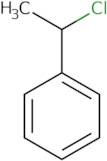(1-Chloroethyl)benzene
CAS : 672-65-1
Ref. 3D-FC35048
| 25g | Arrêté | ||
| 50g | Arrêté | ||
| 100g | Arrêté | ||
| 250g | Arrêté | ||
| 500g | Arrêté |
Informations sur le produit
- (1-Chlorethyl)benzol
- (RS)-Phenethyl chloride
- (±)-1-Phenylethyl chloride
- (α-Chloroethyl)benzene
- .alpha.-Methylbenzyl chloride
- 1-Phenethyl chloride
- 1-Phenyl-1-chloroethane
- Benzene, (1-chloroethyl)-
- Benzene, (α-chloroethyl)-
- Gy1&R
- Voir d'autres synonymes
- alpha-Chloroethylbenzene
- alpha-Phenylethyl chloride
- α-Chloro-α-methyltoluene
- α-Methylbenzyl chloride
- α-Phenethyl chloride
- α-Phenylethyl chloride
- 1-Chloro-1-phenylethane
(1-Chloroethyl)benzene is an organochlorine compound that is used as a catalyst in the production of polymers. It inhibits the formation of chiral products by acting as a catalyst during polymerization reactions. (1-Chloroethyl)benzene is also used to make deuterium-labeled compounds, which are useful when studying chemical reactions and kinetic data. It has been shown to be effective at inhibiting the cationic polymerization of hydrochloric acid with sodium salts and halides, such as chlorine and bromine. This active form can be synthesized by reacting benzaldehyde with chloroethane in an organic solvent, such as dichloromethane or chloroform. This reaction requires the presence of a base, such as potassium carbonate or sodium hydroxide, to neutralize the acidic hydrogen chloride produced in the reaction. (1-Chloroethyl)benzene can also be synthes





